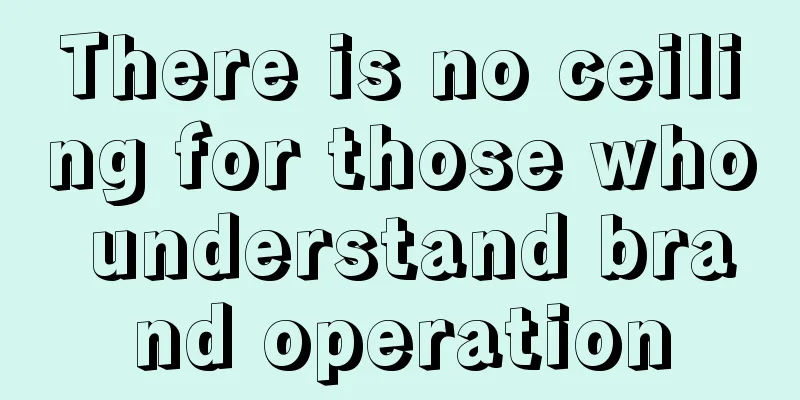There is no ceiling for those who understand brand operation

My journey in brand operation after 9 years in Shenzhen Over the past 9 years, I have really switched a lot of positions in order to understand the entire operation chain, from front-end to back-end, offline, online, Party A, Party B, TOB, TO C. I tried them all one by one, just to understand the whole process from traffic to monetization as clearly as possible, so that I can have a more global perspective when doing brand marketing work later. Because branding is too abstract, it requires actual operational actions to undertake and implement it. Fortunately, several companies that I visited in the past were in the A or B round when I arrived, and when I left, most of them were at the IPO or D round stage. As the company grew rapidly, I worked my way up from copywriting planner to planning director and then to brand manager. If you also want to transform from an operations position to a brand position , you can consider first familiarizing yourself with the full-link operations position from traffic to monetization, or running through the entire monetization closed loop in a project, and then switching to a brand position. In this way, you can combine the operations and brand perspectives. However, I fell into severe depression last year. For a long time, I didn’t even dare to open WeChat, fearing that I would be subjected to cyberbullying again. I even deleted all my friends in Moments to only 150 people, cancelled my Xiaohongshu account, and fell into deep doubt about myself.
After a very detailed life review and communication with friends and a psychologist, I decided to leave Shenzhen, where I had lived for 9 years, and return to my hometown. I calmed down, stayed indoors for 3 months, and focused on taking a course, hoping to make the brand as down-to-earth as possible. During the Spring Festival, I started a new short video series, which unexpectedly had millions of views, making it a small hit. After communicating with several directors, I became more certain of my future direction. From operations transformation to branding, and now to becoming a freelancer, my biggest feeling is: In fact, your academic qualifications will not limit you, bad reviews will not limit you, people who are jealous of you will not limit you, and your superiors who PUA you will not limit you. Only lack of belief, courage, and confidence will limit you. I would also like to give special thanks to Songyue because she once said to me: "I think you are the kind of person who can succeed in anything." You may not imagine how important this sentence is to me. Just this one sentence is really, really healing. A brand operation position might be a better choice for transformation? Last year, when I was doing a brand case analysis training camp with Xiaofang and Yaxuan, Xiaofang deeply dug into the JDs of 600 brand positions on Boss Direct and found three obvious characteristics: First, for brand planning positions, the focus is on the professionalism of the brand management knowledge system, as well as the ability to plan and implement, which requires a foundation in brand awareness. Second, brand management positions require in-depth research and insights into brand communication. Third, brand operation. This position is relatively new, and judging from the 200 JD requirements of Boss Direct Hire, most of the demands are in cross-border e-commerce, and the main capabilities are social media operation and data analysis. This position has low requirements for brand knowledge and is more suitable for operators to try to change positions. So if you want to try to switch to [brand operation], you must start by breaking through the intersection of [brand] and [operation]. Basic cognition may include the following 6: Let’s first sort out the basic understanding of user assets, brand assets, brand quantification, the relationship between operations and products, the relationship between brand and operations, and the relationship between brand and products. Brand thinking milestone: user assets VS brand assets. 01 User AssetsWhat does user assets mean? It means to compare users to a resource, just like human resources and supplier resources. It is a part of the enterprise's production factors and an account that can be quantified, measured and managed. What is the use of user assets? The higher the user loyalty, the better the relationship between the brand and the user, and the more money the company can make from the user. Why did some scholars propose in 2005 that the importance of user assets has far exceeded that of brand assets? Because of the power of information, online power, and community power, the voice of users now exceeds that of brands. In 2004, some scholars put forward the concept that "user assets are more important than brand assets" and even proposed that a company should reshape its strategic direction based on "user assets". What does this mean? I use the Golden Circle model and divide it into 3 points: 【What】What is a brand community? In layman's terms, a brand community is a circle of people who worship a certain brand. 【Why】The operation of brand communities, both online and offline, will become the core of all brand marketing of a company. The quality of brand fans and communities is the key factor that determines whether a company is competitive. [How] In the process of formulating corporate strategy, user assets come first, brand assets take a secondary position, and the brand must be subject to the needs of user asset management. How are the above three points implemented in detail? We look at 6 cases: User asset case analysis: Xiaomi, Harley, lululemon, SAP, Lego, NIU 1. Xiaomi: Taking the community as the “center” of brand marketingXiaomi initially built up its sales market from scratch through brand communities without spending a penny on advertising, and soon reached the scale of 1 million users. From its inception to the present, Xiaomi has been willing to invest a lot of manpower, money, and exposure resources to maintain its relationship with users. Let's look at how Xiaomi has achieved brand community as the core from the three modules of brand marketing: Event operation: Build offline venues for Xiaomi users to gather, create Mi Fan Festival, Popcorn Exchange Meeting, and Xiaomi City Meeting, so that community members can find teams and members who share similar interests. Mi fans are not only the ones who can vote and make decisions, but also the ones who can perform on stage, volunteer to organize activities, and have dinner with the Xiaomi team. Product operation: Create theme IP activities exclusively for Xiaomi users, such as #橙FRIDAY. This is the day when Xiaomi system is updated every week, and it is also the day when community members discuss the updated features every week. Community Operations: Xiaomi has many positions built around "community", such as community platform operations (salary between 30K-60K), community governance operations (salary between 20K-40K), and community product managers. The core of their positions is to be responsible for establishing a healthy community atmosphere, collecting user opinions, refining and feedbacking user opinions, and helping to optimize products. 2. Harley Owners Club: Using user assets as a guiding strategyHarley-Davidson once faced bankruptcy, but because it made the right strategic adjustments, its sales soared to the point where its products were in short supply. Moreover, due to this strategic adjustment, Harley no longer needs to spend money on advertising. This strategic adjustment is so big that if the founder lacks any courage, it cannot be implemented. User assets first, establish a motorcycle owner club In order to establish a closer relationship with users, they founded the Harley Owners Club and promoted club activities in various regions across the United States. Later, 1,400 branches were established around the world. What activities does this club have? There are not only cycling gatherings and cycling events, such as the Davidson Rally, motorcycle rallies, and cycling travel competitions, but also music festivals, beer festivals, weekend gatherings, concerts, car shows, exhibitions, and charity events. These elements together constitute the personal expression of this group. The managers of their company would often communicate with motorcycle riders at weekend social gatherings to solicit their opinions and suggestions. In order to make users recognize the cultural value of the brand, they founded "Harley" magazine, allowing motorcyclists to share their riding experiences, stories and hobbies with each other. Whether it is magazines or various activities, Harley has become the link in the social network of motorcyclists and an important way for this group to express their unique personality and lifestyle. Many people in the Harley community even have the brand logo tattooed on their bodies. What did Harley give up for user assets? In the 1990s, with sales skyrocketing, Harley could have easily increased sales. In addition, overseas agents were particularly eager to open local factories overseas to increase production capacity, but the company gave up. Because they believe that only by ensuring [limited production volume] can the [product quality] of each motorcycle be guaranteed. Only by ensuring product quality can user satisfaction be guaranteed. Because of this persistence, when the owner sells a Harley motorcycle, the resale price is often much higher than the original price. 3. Lululemon’s brand community operation methodAs lululemon entered China, it quickly expanded its user base through [community operations]. In the second quarter of last year, lululemon achieved a strong growth of 61% in the Chinese market. This growth rate far exceeded that of the international market and can be called a mythical speed. Without the power of brand community, lululemon would not have its core competitiveness. Moreover, the quality of lululemon's brand community is composed of the deep emotional connection accumulated through the face-to-face communication between the role of "product educator" and store users. Today, if we search for "lululemon" on Boss Direct, we will find that the positions they are recruiting are very interesting. It can be said that 90% of the job titles are called "Product Educator". There are not only full-time but also part-time positions. They also emphasize in the first sentence of the job description - "The role of product educator is the foundation for the success of our organization", which is enough to illustrate the importance of this position. So what exactly does a product educator do? 1. [Face-to-face] Knowledge sharing: As an expert, interact and build connections with users in stores, and provide product knowledge popularization services. 2. [Face to face] Talk about the community: As a community member, tell users the brand story, share community activities and culture, and convey brand values. 3. Plan [meet-up] activities: As a store member, plan and execute regional community activities that are in line with local culture, such as running clubs, International Yoga Day, etc. 4. SAP forum, the Zhihu of SAAS SAP is a SAAS tool service provider that has established the global standard for ERP (enterprise resource planning) software and has more than 100,000 employees in 157 countries. They have a user exchange forum, which I call the "Zhihu" of the ERP industry. The posting rules are almost like word-by-word instructions, such as "Please do not use the following words in the title: urgent, rapid, and extremely urgent." SAP users can even send reward points to another user. "You have 10 points for each question, and these 10 points can be awarded to the person who answered the question. You can also get 6 points and 2 points for providing helpful answers. As a reward, the person who posted the question can also get 1 point." Let users help each other grow and let users constantly learn new things from each other. This idea is really great. 5. LEGO Ideas, everyone is a designerLugnet is a community spontaneously formed by LEGO users. Later, it evolved into the LEGO ideas platform, where users can share their LEGO designs. If a design is selected, LEGO will put it into production. Users can also vote for their favorite designs, and decide which ones will go into production through collective selection. Through the behavioral design of sharing, voting, and leaving messages, the content platform Lego Ideas has invisibly separated Lego users from the "product" and turned them into a cultural group independent of the product. A community born for inspiration and creativity. 6. Niu Electric's "Niaoyou" CommunityIt only took NIU Electric four years from its establishment to its listing. Their brand community is somewhat similar to the way Lego mobilizes users' design thinking. The Niuyou community encourages users to modify their own "NIU electric vehicles", such as DIY NIU models, key shells, etc., and encourages users to share the stories behind their modifications, modification inspirations, modification prices, modification designs, etc. in the community to shape the group identity of "handicraftsmen" and "electric vehicle modifiers". Moreover, the entrance to this community is placed in the APP, because the APP is needed for navigation and positioning of electric vehicles. By placing the user community entrance here, the community opening rate is guaranteed. Summary: 4 keywords and 3 connotations of brand communityThrough the above 6 cases, we can summarize the 4 keywords and 3 connotations of [brand community], as shown in the following figure: How to enhance brand assets - 2 directions + 1 focus. 02 Brand EquityIf a brand's initial market positioning is vague, or the regional channel management is chaotic, resulting in a vague external brand image, coupled with insufficient promotion budget - It is often difficult to improve [brand awareness] and [perceived brand quality]. However, these two elements are very important in brand assets. There is a relatively simple and crude method, which is the [brand combination method], which can help enhance brand assets. The efficiency of brand management can be improved through the brand portfolio method. It's like, you set up a stall on the roadside to sell apples, the apples are still the same apples, and the passers-by are still the same passers-by. But you divide the apples into [crisper apples] and [softer apples], and design different piles for apples with different tastes. In front of the pile of crisp apples, it was written "Eat this if you have good teeth", and in front of the pile of pink apples, it was written: "Just like you, pink, sticky and cute." This will satisfy users with different taste needs and improve brand conversion efficiency. This simple and crude method is divided into 2 steps: Step 1: Divide users into completely different types of groups, and their user portraits should be completely different. It is best if they are very different from each other in terms of occupational characteristics and psychological characteristics. Step 2: For different user groups, match sub-brands, sub-businesses, and sub-product lines to address this type of user. When matching, consider which brand architecture approach to adopt? Are we referring to the multi-brand structure of Procter & Gamble (which has more than 60 brands)? Or should we refer to General Electric's umbrella brand structure (only retaining the GE logo and name, which are the most important brand assets, but in terms of corporate operations, GE is split into three completely independent companies. All three companies will retain the GE letter logo, but with different colors. The three companies' names all retain GE at the beginning, namely: GE Healthcare, GE Aerospace, and GE Vernova)? Or should we refer to the single brand structure of Siemens ? (Although there are many businesses and product lines under it, they are all called Siemens) Brand assets refer to assets and liabilities associated with a brand name or brand logo that can increase or decrease the value of products or services for a company or users. Brand assets can be broadly divided into the following five categories:
Brand combination method application case: matrix number strategyZhang Qi, Can Ge, Fan Deng, and the marketing goddess Zhao Ran, whose fan base has increased dramatically recently, one of the reasons why they were able to quickly dominate the entire network is that they used the matrix account strategy. (Note: The matrix is only one of the factors. I am not saying that their success is all due to the matrix number strategy.) The matrix number strategy is essentially the application of General Electric's [Umbrella Brand Combination] approach that we mentioned earlier. That is, all accounts still use the same person’s avatar, and the names basically all contain this person’s nickname. The content also comes from the same material, but by changing the editing and splicing methods, titles, covers, etc. of the materials, and passing the platform’s review, a dragnet is used to create hot-selling products. Of course, there must be a professional team behind this method. For ordinary people like us who want to create personal IP, it may be more reliable to choose the first method, which is to divide the account into: main account and life account. After the main account is established, you can bring the small account with you, but the premise is: the fan portraits behind different accounts are indeed different. For example, the target fan portrait of the large account is the business owner, while the target fan portrait of the small account is more C-end traffic. There are two ways to play the matrix number of an enterprise: The first method: Divide the official matrix number into official blue V number + matrix numbers of boss, senior management, employees and pets. For example, Papi Jiang, her team members, the official account of the MCN agency, and the accounts of Mimi and Xiao Mi. The second method: split the accounts into multiple product lines according to different products. For example, the live broadcast room of "Make Friends" is divided into more than a dozen accounts, including "Make Friends Sports and Outdoors", "Make Friends Beauty and Skin Care", "Make Friends Lifestyle and Home", etc. You can also split the account into regional numbers specifically for connecting to users in different cities based on business needs and geographical differences. What inspiration can we get from the above cases when we create our own accounts? 1. If it is operated by a professional team, then use the main account + small account method, but be very careful about the issue of account being blocked. 2. If not, then play it safe and match different strategies according to the manpower of operating the account. Direction 2: Expand the boundaries of brand assets(1) Enhance brand equity through extension into related categories After Master Kong launched a large-scale instant noodle advertisement, it stabilized the instant noodle category and then began to develop into categories such as beverages, cakes, and fast food. Some of these categories were successful because it seized on related categories to extend. The book "Thirteen Laws of Categories" mentions: "The first category that Master Kong successfully entered people's minds was instant noodles. The upstream category extended to convenience foods, and then to food. The parallel categories of instant noodles are biscuits, potato chips, jellies... If you move up to the field of convenience foods, beverages will appear in parallel - and if you move up to the field of food, catering will appear in parallel." This method is more suitable for mature brands and has two steps: 1. Define the brand’s best-selling categories. 2. Start with the hot-selling categories, move upwards, and move in parallel directions, which are all related categories, and then select products for testing. For example, Wonderlab became popular because of its “Little Fatty Bottle”. This product category is meal replacement shakes. The category above is [meal replacement products], and going in a parallel direction are [meal replacement powders], [meal replacement juices], and so on. (2) Enhance brand equity through brand culture extension As a representative of high-quality music, NetEase Cloud Music has extended good music to different industries, such as the hotel industry and the home furnishing industry. This method is more suitable for brands and personal IPs that already have iconic super symbols. The method is: 1. First, define what the brand’s [super symbol] is , such as this record (visual symbol) of NetEase Cloud Music. 2. Expand this symbol to cross-domains/industries with the aim of creating a new user experience , such as cloud music rooms, to create a new hotel living experience. For example, Li Yuling has become popular, and her iconic "sound symbol" can be expanded to the field of navigation and travel. When there are frequent traffic jams, Gaode Map prompts: "Hahaha~ I'm laughing because of the traffic jam~", and the travel experience suddenly becomes magical. (3) Enhance brand equity through brand mergers and acquisitions Before brand theory matured, previous corporate mergers and acquisitions were priced at a maximum of five times the original price. In the 1980s, there were companies willing to pay 25 times the price to acquire companies. The extra price is actually the price of the brand's intangible assets, which has been verified in the capital market. (4) Enhance brand equity through brand globalization Since Anta started its journey of global brand acquisitions, its market value has skyrocketed, ranking third in the global sportswear market value. It also plans to be listed on the New York Stock Exchange in January this year, with an estimated valuation of approximately RMB 70 billion after listing. The article in Jingguantai: "Arc'teryx's 70 billion listing, how far can Anta go on the road of mergers and acquisitions?" mentioned: "Anta's shopping spree has seen it acquire high-end, well-known overseas brands to enhance its own brand influence. Through these acquisitions, Anta has built a comprehensive brand matrix covering everything from fashion to professional, from mass to high-end, and has broadened its influence in the market segments.” So how do you apply this approach to personal branding? For example, if you want to expand overseas platforms, you can try to pay to co-create content with mature overseas bloggers, or ask them to comment on and forward your content, and use local influence to build your account. 1 key point: focus on improving brand association The principles of building a brand and creating an account are the same. The brand's [personality] is very important, and the brand's personality is the key to monetization. So how do you establish this brand label? There is a particularly simple and crude method, which is - Create fixed, long-term, and continuous [theme IP-style] columns to repeatedly strengthen users' [impressions]. Why do this? First, use content columns to shape the brand’s ideology and personality labels. Second, use the activity column to create a label for the brand’s personalized behavior. But how can we solidify this label through content operation and activity operation? I divide this process into three steps: Step 1: Preliminarily define the label of brand impression. How do these label words come from? From questionnaires, by posting questionnaire links/QR codes in public accounts, communities, videos, mini-programs, and apps, and doing word cloud analysis to see what users recognize most. Step 2: Choose the right label. This label must be one that is closer to the monetization of your product. For example, if you sell milk, "pure and natural" is a good selling point label, and "simple and honest" is a good character label. We can see from the survey what words are the most popular among users, and whether they represent some kind of psychological motivation that is conducive to the conversion of this product category? If so, it can be included in the tentative tag vocabulary. Step 3: Plan thematic columns based on the initially screened tags. Whether it is a personality label or a selling point label, we can focus on the discussion based on the table below. 1. Do the existing content columns and activity columns need to be upgraded in terms of branding? 2. Is the combination of different columns reasonable and can it enable users to have a strong sense of label recognition? 3. How to upgrade the branding of existing columns? That requires redesigning and redefining every aspect including vision, sound, concept, models, costumes, props, activity interactions, prizes, processes, etc. For example, Chi Zao's video column with the theme IP "Quitting Your Jobs to Experience 100 Careers" conveys the positive energy of actively exploring life, rather than the idea of passively avoiding work. How is this value reflected in the video? Each of her videos has a slogan that she shouts out loud - " Dress up beautifully and go to work!" Without this sentence, the whole video seems to have changed. Moreover, her writing is particularly good. She can sublimate emotions from different professional details and see the beauty in ordinary people's daily lives. If others want to copy her, they can only copy the form, but the spiritual core is difficult to copy. For example, Guanxia’s product category is oriental aromatherapy, and its personality label is the introverted and solitary character of the East. 1. Activity level: Whether it is through handwritten greeting cards, launching a small number of new products in the early stage, and never doing promotions, or creating groups, but sending private messages to users, sending customized gifts to customers, and choosing a small number of carefully selected bloggers to cooperate with, these behaviors are all reinforcing this personality trait. 2. Content level: The content of traditional oriental aesthetics that we continue to work on is to establish and strengthen the selling point label of "Oriental aesthetics". If we want to operate an official corporate account, how do we plan from the perspective of brand operation? It’s still the same three steps: The first step is to apply for a budget, find users to do testing, and find out what the keywords of users’ brand impression are. The second step, from the perspective of product conversion, we choose 1 personality label and 1-2 selling point labels. The third step is to plan content columns and activity columns with theme IPs, and consider whether this column can strengthen this label from all aspects of concept, vision, and interaction/behavioral design. The last small case is planned according to the above steps: How to measure brand equity? — 2 evaluation scales. 03 Brand QuantificationPreviously we talked about improving brand assets, but how do we measure brand assets? We can solve this problem in 2 ways. The first is to rely on third-party professional companies. They have special technical means and brand value assessment models to make measurements. Some of them will also issue global brand value rankings every year. The second way is through an evaluation scale. The most famous scales, in addition to the brand Big Five personality test scale, are these two: the four-dimensional measurement scale of brand experience and the emotional attachment scale. These scales are based on academic research. 04 Brand & Operation & ProductThe relationship between operations and branding: realism and idealism. I think operations and branding are similar in many concepts, but operations focus on more practical things, while branding is more idealistic. The picture below shows some similar concepts I summarized. I divided them into two groups for comparison. The one with a yellow background is the operation group, and the one with a red background is the brand group. 1. What is the difference between content operation and the 4C process of brand creation? They all emphasize content marketing, but the 4C process of brand creation is broken down into four steps. 2. What is the difference between content operation and sensory branding? The former emphasizes "how to attract and retain users through content", while the latter emphasizes "how to build a brand through sensory means". 3. What is the difference between content operation and brand passion? The latter emphasizes that the branding process is a process of "ignition", a process of injecting brand value into the heart and igniting inner passion. 4. What is the difference between user operation and relationship marketing? First, from the perspective of purpose, user operation is rational, and is an operation method aimed at user activity, retention, and payment, while relationship marketing is emotional, and compares the relationship between brand and user to the relationship between people, in which emotion plays a heavy role. Second, from the perspective of the object, user operation focuses on the relationship between the brand and all users, while relationship marketing focuses more on the "one-to-one" relationship between individual users and brands. 5. What is the difference between user operation and brand community? The former is "my brand" and the latter is "our brand" 6. What is the difference between user operation, customer assets and brand ecosystem? User operation now refers more to private domain users. If the definition of users is expanded, customer assets mean fans and community users, and the brand ecosystem means broader users, including merchants, service providers, logistics and other partners. 7. What do event operations have in common with brand enhancement and brand activation? These are all ways to increase activity. 8. What is the difference between the funnel model and the 4° iron powder model? The funnel model is a universal model, while the 4° iron fan model is only suitable for personal brands. The relationship between operations and products: accompanying you from birth to adulthood What is the relationship between operations and products? First, from a time perspective, operations enter the product process before product design. Second, from the perspective of subject relationships, the book "Learning Operations from Scratch" mentions: " Any means that can help promote products, promote user use, and improve user awareness are operations ." Operation is the process of making a good life plan for the product, raising it step by step, launching it to the market, and helping the child grow through market feedback. The relationship between brand and product: you are in me and I am in you. 1. From the perspective of dimension : products have only one-dimensional space, while brands have three-dimensional space. In terms of symbols, symbols and experience, brands have independent attributes and values that are different from products. 2. From the perspective of the brand: Brand proposition starts from the product. Among the core information conveyed by the brand, the product belongs to the argument support level, and among the brand stories, the story of the original intention of the product is also a very important form of presentation. Author: Ye Ma Fan, WeChat public account: Ye Ma Fan |
<<: The latest major revision! WeChat Q&A will be in full swing in 2024
>>: 5 marketing common senses that most business owners and CMOs tend to overlook!
Recommend
From the fact that Keep medals sold for 500 million, I summarized two cognitive gains:
Some time ago, Keep sold medals for 500 million yu...
Can I be arrested if I only collect money but don't ship the goods? Is not shipping considered a scam?
In foreign trade business, some people may conside...
What are the types of cross-border e-commerce risks? Tell you how to reduce the risks
With the progress of globalization, cross-border e...
What can you sell with a US Amazon account? Which ones are profitable?
Many friends choose the US site on Amazon, so ever...
What level does shein belong to? Is shein considered a large company?
Shein is a fashion e-commerce brand that has been ...
Is Focus Media old? | 5000 words to reread the value of elevator media
Is Focus Media old? The author analyzes the curren...
Uncovering the secrets of Tyndall, more marketing jargon
Fashion trends change rapidly and consumers keep u...
Revealed: What are the characteristics of the user portrait system of large companies?
In the era of big data, user portraits have become...
How to get keywords on the first page of Amazon? Method introduction
There is one thing that Amazon merchants must lear...
What are the dedicated lines for cross-border e-commerce logistics? What are the logistics models?
With the rapid development of cross-border e-comme...
Is the total balance displayed in cross-border e-commerce stores in US dollars?
In the field of cross-border e-commerce, many sell...
What needs to be done right for Xiaohongshu store to sell 5 million goods?
You wouldn't have thought that Xiaohongshu can...
Three transformations of a company from small to large
This article mainly introduces the process of corp...
SHOPLINE launches Super Affiliate New Customer Incentive Program
SHOPLINE launches the Super Affiliate New Customer...
Are foreign trade stocks genuine products? What does foreign trade stocks mean?
When we buy things online, we sometimes see some m...









